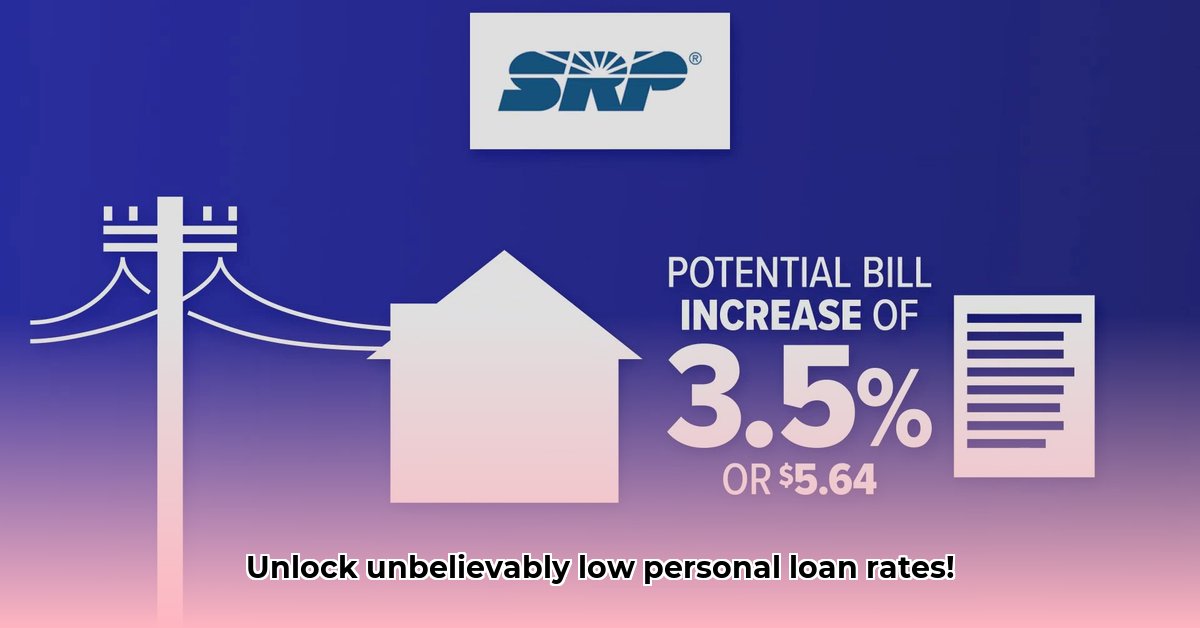
Securing a personal loan with a low interest rate can significantly impact your overall borrowing costs. This guide will equip you with the knowledge to navigate the process effectively and make informed decisions when choosing an SRP personal loan or a loan from another lender. We'll explore the key factors influencing your rate, decipher the often-confusing language of APRs and fees, and provide actionable steps to secure the best possible deal.
Understanding the Factors Influencing Your Interest Rate
Your personal loan interest rate isn't arbitrary; it's a reflection of several interconnected factors that lenders carefully consider. Let's break down the key elements:
Credit Score: This three-digit number represents your creditworthiness. A higher score (700 or above is generally considered good) signifies lower risk to lenders, resulting in lower interest rates. Conversely, a lower score indicates higher risk and consequently higher rates.
Debt-to-Income Ratio (DTI): This ratio shows the proportion of your monthly income used to repay existing debts. A low DTI (typically below 36%) demonstrates responsible financial management, increasing your chances of securing better interest rates. A high DTI, on the other hand, suggests potential difficulties in repayment, leading to higher rates.
Annual Income: A stable and substantial income reassures lenders of your repayment capacity. Consistent income streams generally translate into more favorable loan terms.
Location: Interest rates can vary slightly depending on your location and the lender's market presence. This difference is often due to local economic conditions and lender-specific strategies.
Loan Amount: Larger loan amounts often carry slightly higher interest rates because they represent a greater risk for the lender.
Data from various sources show personal loan interest rates ranging significantly, from 7% to 36% APR. These discrepancies highlight the importance of detailed comparison shopping, understanding that loan offers may differ due to lenders' risk assessments, specific loan products offered, and the timing of data collection.
Decoding APR and Associated Fees
The Annual Percentage Rate (APR) represents the total annual cost of borrowing, encompassing the interest rate and all fees. Understanding your APR is crucial for comparing loans accurately. Don't be misled by low advertised interest rates; always consider the APR to get the complete picture. Common fees include:
- Origination Fees: Charged upfront to process the loan application.
- Prepayment Penalties: Penalties applied when you repay the loan early.
- Late Payment Fees: Charged for missed or late payments.
Carefully reviewing the total APR and all associated fees helps you determine the true cost of the loan, enabling apples-to-apples comparisons between lenders.
Actionable Steps for Securing Lower Rates
The steps to secure a lower interest rate vary depending on your credit situation:
For Borrowers with Good Credit (Credit Score 700+):
- Shop Around: Compare offers from multiple lenders (at least three).
- Pre-qualify: Check your eligibility without impacting your credit score. This allows for comparison shopping before a formal application.
- Negotiate: Don't hesitate to negotiate for a lower rate, especially if you have multiple competitive offers.
For Borrowers with Fair or Poor Credit:
- Improve Credit Score: Address any negative items on your credit report. This is a long-term strategy requiring consistent effort. Focus on on-time payments and debt reduction.
- Secured Loan: Consider a secured loan if you have valuable assets to use as collateral. This reduces risk for the lender.
- Explore Co-signers: A co-signer with excellent credit can significantly improve your chances of approval and securing a lower rate.
Additional Strategies (for all credit levels):
- Increase Income: A higher income signals greater repayment capacity.
- Reduce Debt: Lowering your DTI improves your chances of securing a better interest rate.
Lender Comparison (Illustrative Example)
The following table provides a simplified comparison. Note: Actual rates and fees vary significantly between lenders and change frequently. Always confirm directly with the lender before making any decisions.
| Lender | APR Range (Approximate) | Loan Amount Range ($) | Typical Fees |
|---|---|---|---|
| Lender A | 7%-15% | 5,000 - 50,000 | Varies |
| Lender B | 9%-20% | 2,000 - 30,000 | Varies |
| Lender C | 12%-25% | 1,000 - 20,000 | Varies |
Understanding Potential Risks and Regulatory Protections
Credit scoring models, while helpful, aren't perfect. Potential biases and inaccuracies can influence your rate. However, regulations like the Truth in Lending Act (TILA) aim to ensure transparency in APR calculations and fee disclosures, protecting consumers from predatory lending practices. Careful review of loan documents is essential before signing.
Key Takeaways:
- Personal loan interest rates are influenced by a complex interplay of factors.
- Understanding APR and all associated fees is vital for comparing loans effectively.
- Proactive steps, tailored to your credit situation, can significantly impact your interest rate.
- Regularly reviewing your credit report and score is beneficial in planning for future loans.
Remember: This information is for educational purposes. Consult with a financial advisor for personalized advice.